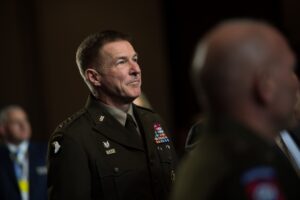The Army’s chief of staff said the service’s investments in a suite of new long-range precision fires can play a critical role supporting future operations in the Indo-Pacific, aligning with recent details of the new Pacific Deterrence Initiative (PDI) that calls for such a capability.
Gen. James McConville told reporters Thursday the long-range fires ability to penetrate adversaries’ Anti-Access/Area Denial (A2/AD) capabilities will open up more options for the Air Force and Navy as officials assess operational and funding needs for future INDOPACOM requirements.

“Some of the concepts that we think we’re going to need in the future are the ability to maybe suppress air defense and we’re going to do it from a strategic range. It’s going to put more challenges on a potential competitor. The ability to set up our own Anti-Access/Area Denial capability is going to put pressure on those who are developing a sea-based capability,” McConville said.
The recently released $27 billion PDI funding plan specifically calls for $408 million in FY ‘22 to invest in ground-based long-range fires capable of distances greater than 500 kilometers, with the intent to spend another $2.9 billion from FY ‘23 to ‘27 on the weapons (Defense Daily, March 2).
McConville added he believes the proposed cost for such long-range fires capabilities is “fairly reasonable for the capability that’s going to be provided.”
The Army’s long-range precision fires modernization effort currently covers hypersonic weapon development, a new mid-range missile effort and the future Precision Strike Missile program.
“The value of a land-based [capability] is that it’s 24/7. It’s always there. It’s tough to sink some of the islands [in the Indo-Pacific]. You have the mobility to do that. You’re in a position to move,” McConville said. “What we’re doing is providing an option that may in the future enable both air and maritime maneuver, which is something different than we’ve done in the past.”